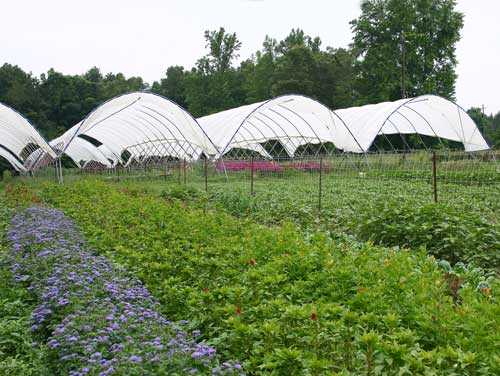FAO emphasizes that both the conservation of biological diversity for food and agriculture and its sustainable use is necessary for providing food, improving people’s economic, social and environmental conditions and meeting the needs of future generations, in particular the rural poor. In this context, AGP assists member countries in developing capacities to manage biodiversity and the ecosystem services it provides to increase options for optimizing agricultural production.
Food production will have to increase by 50 per cent to feed a population of 9 billion people by 2030. This brings agricultural production under intense pressure. Alongside the demands on agricultural sector for increased production, there are also increasing expectations and needs for cultivation practices to be sustainable. Increased demand for crop production— for food, fibre and non food agricultural products (in particular bio-energy crops) — together with the impacts of climate variability and change are creating the need to rethink agricultural systems and redirect them to respond to new demands.
Increases in production have traditionally involved increased dependence on pesticides and fertilizers and overuse of water that can degrade soils and water resources. Cultivation practices, however, are undergoing a shift to move from dependency on traditional inputs and from chemical-based intensification to forms of biological intensification that draws on the richness of biodiversity and natural resources to provide ecosystem services. Promoting the healthy functioning of ecosystem services, and doing so through ecosystem-based approaches, can increase the options available for optimizing agricultural production sustainably (CSD-16).
Biodiversity for Food and Agriculture
Biodiversity – the variety and variability of animals, plants and micro-organisms at the genetic, species and ecosystem levels – is necessary to sustain key functions of the ecosystem, its structure and processes. Biodiversity for food and agriculture can be managed to maintain or enhance ecosystem functions to provide options for the optimization of agricultural production, and contribute to the resilience of ecosystems for risk mitigation. Indeed, biodiversity enhances ecosystem services because those components that appear redundant at one point in time become important when changes occur.
Why is biological diversity important to agriculture? Some examples:
Crop genetic diversity has a critical role to play in increasing and sustaining production levels and nutritional diversity throughout the full range of different agroecological conditions. Diverse organisms contributing to soil biodiversity perform a number of vital functions that regulate the soil ecosystem, including: decomposition of litter and cycling of nutrients; converting atmospheric nitrogen to an organic form, and reconverting this to gaseous nitrogen; and altering soil structure. Diversity in deliberate plantings on-farm- through crop rotations, crop species mixtures, permanent soil cover crops employed in conservation agriculture or agroforestry – are oft used techniques to increase yield stability, and increase soil fertility. Grassland and pasture/crop systems that diversify and integrate ruminant livestock and crops tend to be more sustainable because they provide opportunities for rotation diversity, perennial cultivation, and greater energy efficiency. The introduction of grazing animals at certain points in farming cycles may help to break down plant material and increase nutrient availability. Predators and parasites which attack pest insects or pathogens on crops, or plant-feeding insects which attack crop weeds contribute to pest regulation. Beyond these direct trophic relationships, a web-like pattern of interactions amongst diverse life-forms on-farm can deliver additional benefits. For instance, crop production may benefit from benign micro-organisms which colonize crops and their habitats such that pathogens do not establish, or from non-crop plants which are attractive to pests and thereby reduce their numbers on crops. Taken together, this directly- and indirectly-acting biodiversity may create “pest suppressive” conditions. Greater on-farm diversity of plants, greater closeness between crop plants and thus coverage of bare ground, and more perennial cultivation may be measures lending greater resistance to invasion of farming systems by noxious species, and assist in weed management. Pollinators are essential for orchard, horticultural and forage production, and contribute to improvements in quality of both fruit and fiber crops. Healthy pollination services are best ensured by an abundance and diversity of pollinators, in large part provided by wild biodiversity.
Ecosystem Services and Their Importance For Agriculture
Ecosystem services are defined as “the benefits provided by ecosystems to humans”. Many key ecosystem services provided by biodiversity, such as nutrient cycling, carbon sequestration, pest regulation and pollination, sustain agricultural productivity. Promoting the healthy functioning of ecosystems ensures the resilience of agriculture as it intensifies to meet growing demands for food production. Climate change and other stresses have the potential to make major impacts on key functions, such as pollination and pest regulation services. Learning to strengthen the ecosystem linkages that promote resilience and to mitigate the forces that impede the ability of agro-ecosystems to deliver goods and services remains an important challenge.
Ecosystem services can be:
Supporting (e.g. soil formation, nutrient cycling, primary production)
Provisioning (e.g. food, fresh water, fuelwood, fiber, biochemicals, genetic resources)
Regulating (e.g. climate regulation, disease regulation, water regulation, water purification, pollination)
Cultural (e.g. spiritual and religious, recreation and ecotourism, aesthetic, inspirational, educational, sense of place, cultural heritage).
Adapted from: Ecosystems and human well-being: a framework for assessment. Millennium Ecosystem Assessment. 2003. World Resources Institute.
Managing Biodiversity and Ecosystem Functions for Sustainable Agricultural Production
Biodiversity is an important regulator of agro-ecosystem functions, not only in the strictly biological sense of impact on production, but also in satisfying a variety of needs of the farmer and society at large. Agroecosystem managers, including farmers, can build upon, enhance and manage the essential ecosystem services provided by biodiversity in order to work towards sustainable agricultural production. This can be achieved though good farming practices which follow ecosystem-based approaches designed to improve sustainability of production systems. They aim at meeting consumer needs for products that are of high quality, safe and produced in an environmentally and socially responsible way.
The conservation and enhancement of biodiversity in cropping systems both above and below ground (e.g. soil biodiversity) are part of the foundation of sustainable farming practices. Such measures also lead to improved biodiversity in other parts of the environment which are adjacent to but not directly part of the cropland – such as water bodies and the broader agricultural landscape. The composition and diversity of planned biodiversity (for example selected crops) strongly influences the nature of the associated diversity – plant, animal and microbial. A challenge is to integrate, through ecosystem approach strategies, the planned biodiversity that is maintained with the associated diversity (for example, wild pollinators).
Some ecosystem-based production practices
Conservation Agriculture (CA)
Integrated rice management systems such as the System of Rice Intensification (SRI)
Integrated Pest Management (IPM) for plant and animal diseases
Integrated Production and Pest Management (IPPM)
Integrated Plant Nutrition Systems (IPNS)
Integrated Weed Management (IWM)
Maintenance of biodiversity, including crop-associated biodiversity, is necessary to ensure the continued supply of goods and services such as:
(i) Evolution and crop improvement through breeding – the interaction between the environment, genetic resources and management practices that occurs in situ within agro-ecosystems ensures that a dynamic portfolio of biodiversity for food and agriculture (agricultural biodiversity) is maintained and adapts to changing conditions;
(ii) Biological support to production – support is provided by the organisms that make up the biological diversity of the agro-ecosystem. For example, soil fauna and micro-organisms, together with the roots of plants and trees, ensure nutrient cycling; pests and diseases are kept in check by predators and disease control organisms, as well as genetic resistances in crop plants themselves; and insect pollinators contribute to the cross-fertilization of outcrossing crop plants; and
(iii) Wider ecological functions – valuable ecological processes that result from the interactions between species and between species and the environment include the maintenance of soil fertility, water quality and climate regulation.
Source: http://www.fao.org/agriculture/crops/thematic-sitemap/theme/biodiversity/en/




